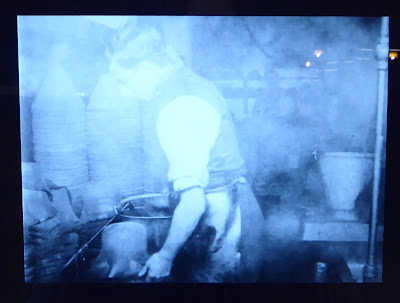My big worktable on which I do my cutting out is temporarily out of commission, so I'm having to use my dining table instead. Obviously, this gets used for lots of things, and if I want to do any cutting out, I have to clear it first. So to minimise the time spent clearing things off and putting things back, I have decided to try batch cutting. The intention is to cut out the pieces for three separate dresses at once, and then sew them.
 |
| My starting point |
I know that lots of people do this, possibly for the reason for which I'm giving it a go, but I have never tried it before. Given my fondness for squirrel projects, I have always been worried that I will end up with multiple cut-out but unsewn projects lying around. So I will have to be disciplined for once, and actually do the projects I have planned!
To improve the (limited) chances of this actually happening, I am sticking with patterns which I have used before and which I therefore know I can make reasonably easily and quickly. Like the Grace dress, the existing versions are all in heavy rotation in my wardrobe.
First up, Simplicity 4463. I have found that I greatly prefer this, with its simpler skirt, to its reissue version 1777.
 |
| The original illustration |
It's very much a winter dress however, made in a thick, slightly fluffy, cotton. I decided that I want a summer version as well, and I am going to use a cotton lawn which has been in my stash for a while. I originally had other plans for it, but decided that it would be perfect for this project. As a slight change, I am going to make view 1, albeit all in the same fabric.
 |
| The original plan |
Butterick 2535 is another easy-to-wear 1940s dress which gets a lot of use. (My taste seems to be moving away from full-skirted dresses, and I don't think that it's just because of all the ironing involved!)
 |
| I haven't decided on sleeves, yet |
For this I'm using a cotton print which is, gasp, not blue! I rarely wear brown, so I'm not entirely sure how this will turn out, but I do need to try other colours occasionally.
 |
| Another fabric bought because I liked the print |
Finally, Style 1271. I don't feel that view C of this has really worked. I don't know exactly what the problem is, but it just feels frumpy. It has been put aside while I consider how to tweak it. View B, however, always gets compliments when I wear it.
 |
| My versions of B and C turned out very differently |
I wasn't really planning to make another one of these, but then I spotted this remnant, which I thought would be perfect. The stripes are across the fabric, but I will cut it out with the stripes running lengthwise.
 |
| Jaunty! |
It's going to be a challenge to cut out, as there isn’t a lot of fabric. At least that has limited the damage to the Stashometer.
 |
| It was going quite well! |
I must admit that even I am dubious about how well batch cutting will work for me, but here goes!














































